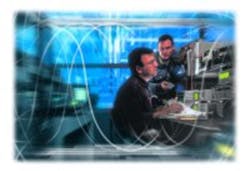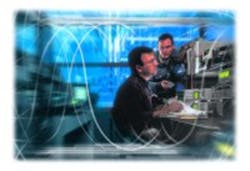Fifteen years ago, calibration labs were staffed with a preponderance of highly trained, former military metrologists who could define their local calibration needs and devote enough time to ensure that the results were accurate. Often times, these metrologists were trained under MIL-STD-45662A. The adequacy of measurement standards was a relatively simple calculation based on the ratio of the accuracy of the standard vs. the accuracy of the unit to be calibrated.
Times have changed—and how. Market forces press calibration labs to take a hard look at increasing performance and reducing costs with fewer resources. At the same time, international measurement requirements have a major impact on calibration labs. And with the addition of highly automated equipment with turnkey calibration procedures available through the Internet, calibration labs are changing the way they operate.
Glossary
| A2LA | American Association for Laboratory Accreditation |
| ANSI | American National Standards Institute |
| BIPM | Bureau International des Poids et Mesures |
| DKD | Deutsche Kalibrierdienst |
| GUM | Guide to Uncertainty Measurement |
| IEC | International Electrotechnical Commission |
| ISO | International Organization for Standardization |
| MRA | Mutual Recognition Agreement |
| NCSL | National Conference on Standards Laboratories |
| NIST | National Institute for Standards and Technology |
| NVLAP | National Voluntary Accreditation Program |
| PMEL | Precision Measurement Equipment Laboratory |
| TAR | Test Accuracy Ratio |
| UKAS | United Kingdom Accreditation Service |
International Requirements
Implementation of the stringent international measurement uncertainty requirements demanded by ISO/IEC (see Glossary, page 60) 17025 is increasing. The need for improved calibration lab performance and workload coverage will continue unabated. But there are other drivers to consider as well.
The U.S. military set the calibration standards with MIL-STD-45662 in 1980 and MIL-STD-45662A in 1988. The latter document established a rule that many military-trained metrologists still live by: The TAR of the standard to the unit to be calibrated must be at least 4:1.
In the early 1990s, the military standards were superseded by ANSI/NCSL Z540 – 1994. This standard not only carried forward the philosophy of TARs, but also included elements of ISO Guide 25, a calibration standard largely driven by the European Community.
ISO Guide 25 emphasizes measurement uncertainty analysis and does not specifically refer to TARs. This philosophical shift has dramatically changed the work product in a calibration laboratory.
The ground rules for claimed measurement uncertainty are defined by GUM. GUM is a standard all calibration labs must follow to determine a measurement uncertainty against a given process or measurement. This ensures that all contributions of uncertainty have been accounted for.
There are various flavors of the GUM, some developed by BIPM, NIST, and other national measurement institutes. But they all explain—in excruciating detail—the methodology of analyzing all components of measurement uncertainty.
In 1999, ISO Guide 25 formally changed to ISO/IEC 17025, also known as the General Requirements for the Competence of Testing and Calibration Laboratories. This standard, not surprisingly, became widely accepted in Europe and other parts of the world, but only now is being adopted in North America.
With calibration labs in North America, Asia, and Europe now adopting MRAs, it is important to follow common ground rules. For this reason, there is a move in North America toward adopting ISO/IEC 17025.
Along with this change in philosophy, accreditation of laboratories is a growing phenomenon in North America. In Europe, most calibration laboratories are accredited. Among other things, accreditation assures the competency of measurement uncertainty analysis. Accreditation is one of the backbones of the MRAs, assuring that each calibration laboratory adheres to ISO/IEC 17025.
To categorize any group of labs, it is important that the accreditation bodies have a common set of ground rules. Europe’s increasingly stringent calibration system serves as a model for accreditation of U.S. calibration labs with particular focus on the process, the claimed measurement uncertainty, and the skills of the person managing the process.
There is some residual national pride in calibration standards. For example, Fluke laboratories will continue to be accredited simultaneously by several international organizations such as NIST and A2LA in the United States, DKD in Germany, and UKAS in the United Kingdom.
The standardization of accreditation across borders will continue. One benefit is the military’s decreased interest in auditing our calibration lab in Everett, WA, now that it has NVLAP accreditation.
While virtually all calibration labs in Europe are accredited, along with this accreditation comes the need for more complex calibration certificates and reports. Currently, there is no requirement for accreditation to European standards in North America. In fact, very few U.S. calibration labs have attained accreditation. The coalescing of calibration standards and procedures around IEC 17025 is having its effect on documentation in all laboratories.
Bridging U.S. and European documentation methodology, procedures may include writing a closely defined coversheet and creating a detailed test report containing measurement uncertainty data required by IEC 17025. A calibration lab metrologist may spend an hour or more just preparing a single report. This investment in time, money, and equipment still is relatively rare in the United States but has become standard operating procedure in Europe.
In addition to providing more detailed reports, the equipment calibration labs’ need to achieve this level of uncertainty analysis must be simultaneously more sophisticated and user-friendly. While these would appear to be mutually exclusive movements, major industry initiatives have succeeded in providing equipment that exhibits higher levels of accuracy and stability and increased functionality and versatility while enhancing ease of use. The end is near for the general-purpose equipment that metrologists have relied upon.
Preparing the Work Force
When we consider the skills needed to address today’s more demanding standards, it is apparent that calibration laboratories must function on a completely different plane. Unlike a decade ago, managers and technicians are coming into calibration labs without the benefit of PMEL training or military experience.
In many cases, surprisingly, the new work force may have little calibration lab experience at all. Yet they must deliver more extensive information and work to more exacting standards. This situation requires that calibration hardware and software be intuitive, easy to use, and versatile enough to handle a broad spectrum of measurement situations.
Reliance on multifunction equipment, primarily aimed at calibration applications, can help mitigate many of these training challenges. Improved software also can be used to automate many procedures for improved calibration lab consistency. More on-the-job education and training, however, remain issues that won’t be resolved easily without further industry involvement in academic or certified educational programs.
To address these training problems, Fluke currently supports a variety of educational initiatives in colleges and technical schools around the country. In addition, we offer a strong professional training program that ranges from on-site instruction in the principles of metrology to comprehensive, computer-based training of calibration software.
While this effort is a step in the right direction, the question of where the next generation of metrologists will come from remains unanswered.
The Demand for Productivity
Cost cutting has hit every level of calibration operations, making return on investment and productivity analyses more important than ever. Even though enhanced calibration lab efficiency can be achieved with quicker setups, fewer mistakes, and other process improvements, widespread adoption of new technology is a necessity.
Routine and complex calibration tasks must be automated and simplified to produce more accurate results with greater measurement detail and fewer labor hours. With new software that contains self-documented procedures, there is added assurance that all operators complete all tests and collect appropriate test data consistently.
Meeting Real-World Expectations
The calibration lab of the 21st century still is chartered to maintain the measurement quality and traceability of its workload. It is, however, looked upon now as a cost center like every other organizational segment of industry. The squeeze between calibration laboratory productivity, quality, and performance on one hand and the reduced supply of trained personnel on the other has become a crucial topic as nearly all metrologists face ever-greater performance and economic demands.
While the global economy still is uncertain, the demand for new calibration technology and capability remains strong. Hardware and software introduced this year focus primarily on customers’ expectations for better product performance, accuracy, and ease of use that will provide a quick return on their calibration investment dollar, euro, or yen.
Assuring Consistency
Today’s calibration lab technicians have high expectations for the software they must use regularly. They are comfortable using popular word-processing and spreadsheet products such as Microsoft Word and Excel and familiar with many of the features and capabilities of these programs.
Along with their high level of acceptance and expertise with main-market operating systems is the expectation that all new calibration software will have the same look and feel of the software tools to which they are accustomed. The closer the new products can simulate this industry standard, the more comfortable the user is.
Software procedures must be readily consistent with the equipment manufacturer’s recommendations. They also must offer the option of customization to meet the user’s current and future quality policies.
Improved Performance
Precision measurement tools are available to allow metrologists to undertake a multitude of everyday measurements with just one box. By reducing equipment used from as many as eight instruments to one, there are tremendous savings in time with a significant reduction in complexity and support costs.
Accuracy and Stability
Measurements need to be repeatable today, tomorrow, next week, and even next year. That’s why stability must be treated with the same priority as accuracy. For instance, the reference-standard performance of some calibration equipment on the market today provides one-year accuracy of 3.0 ppm and 20-min stability of 0.12 ppm. This new-generation stability is achieved without the need for auto-calibration or self-calibration routines.
Conclusion
While the challenges facing the precision measurement industry are very real, significant remedies are available. The calibration equipment industry will continue to make giant leaps in addressing the concurrent demand for workload, skill, and time optimization with even more global innovation.
The accreditation issues in the United States are relatively new when compared to the long-established European accreditation system. It is the customer who benefits from accreditation when the measurement capabilities of the accredited labs are in the public domain. This open access provides a customer with freedom of choice in the knowledge that the accreditation authorities are reputable and have agreed with the claimed measurement parameters and measurement uncertainty of the calibration labs.
About the Author
Thomas Johnson, general manager at Fluke Precision Measurement, graduated from Rensselaer Polytechnic College with a bachelor’s degree in electrical engineering and a master’s in business management. He has devoted 25 years to the field of precision measurement with the last 15 spent at Fluke. Fluke, P.O. Box 9090, Everett, WA 98206, 425-446-5721, e-mail: [email protected]
For More Information
Calibration application notes and papers
www.rsleads.com/209ee-235
Return to EE Home Page
Published by EE-Evaluation Engineering
All contents © 2002 Nelson Publishing Inc.
No reprint, distribution, or reuse in any medium is permitted
without the express written consent of the publisher.
September 2002

